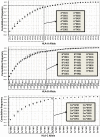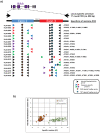High-throughput high-resolution class I HLA genotyping in East Africa
- PMID: 20505773
- PMCID: PMC2873994
- DOI: 10.1371/journal.pone.0010751
High-throughput high-resolution class I HLA genotyping in East Africa
Abstract
HLA, the most genetically diverse loci in the human genome, play a crucial role in host-pathogen interaction by mediating innate and adaptive cellular immune responses. A vast number of infectious diseases affect East Africa, including HIV/AIDS, malaria, and tuberculosis, but the HLA genetic diversity in this region remains incompletely described. This is a major obstacle for the design and evaluation of preventive vaccines. Available HLA typing techniques, that provide the 4-digit level resolution needed to interpret immune responses, lack sufficient throughput for large immunoepidemiological studies. Here we present a novel HLA typing assay bridging the gap between high resolution and high throughput. The assay is based on real-time PCR using sequence-specific primers (SSP) and can genotype carriers of the 49 most common East African class I HLA-A, -B, and -C alleles, at the 4-digit level. Using a validation panel of 175 samples from Kampala, Uganda, previously defined by sequence-based typing, the new assay performed with 100% sensitivity and specificity. The assay was also implemented to define the HLA genetic complexity of a previously uncharacterized Tanzanian population, demonstrating its inclusion in the major East African genetic cluster. The availability of genotyping tools with this capacity will be extremely useful in the identification of correlates of immune protection and the evaluation of candidate vaccine efficacy.
Conflict of interest statement
Figures


References
-
- Rimmelzwaan GF, Fouchier RA, Osterhaus AD. Influenza virus-specific cytotoxic T lymphocytes: a correlate of protection and a basis for vaccine development. Curr Opin Biotechnol. 2007;18:529–536. - PubMed
-
- Stenger S. Cytolytic T cells in the immune response to mycobacterium tuberculosis. Scand J Infect Dis. 2001;33:483–487. - PubMed
-
- Parham P. MHC class I molecules and KIRs in human history, health and survival. Nat Rev Immunol. 2005;5:201–214. - PubMed
-
- Anthony Nolan Research Institute. 2009. Full List of HLA Class I Alleles Assigned July 2009.
Publication types
MeSH terms
Substances
LinkOut - more resources
Full Text Sources
Research Materials
Miscellaneous

